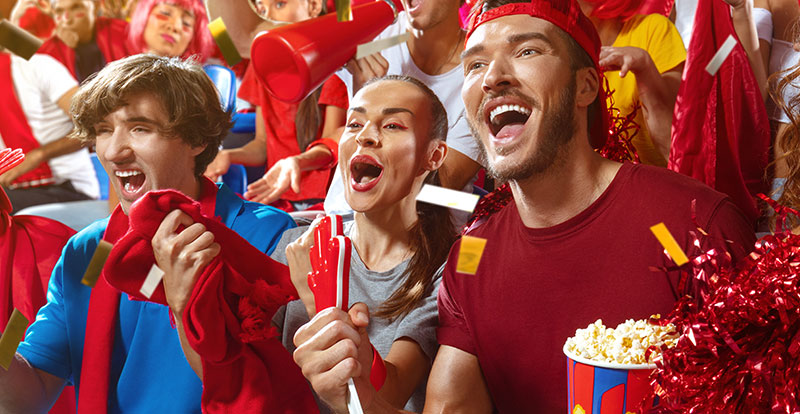College Football Season, Influx of Crowds, Safety Measures

College football has over 47 million dedicated fans, making it the nation’s second most popular sport.
As crowds gather to support their favorite teams, an enthusiastic day at the stadium can quickly turn to disaster.
Large crowds and rowdy behavior combined with one of the most dangerous college sports is a recipe for accidents and injuries.
What measures can you take to help ensure the safety of all spectators, athletes, and volunteers on campus?
Keep reading to learn tips and tricks for quelling and protecting crowds and students without taking away from the spirit of college football.
Crowd Control
Even before Covid-19 was a concern, large crowds at sporting events cause a long list of safety hazards and potential dangers.
Surging Crowds
There’s something undeniable about the energy and fanaticism created at college sporting events — and it doesn’t take long for things to spiral out of control.
Cheering and chanting quickly turns to swaying back and forth and, eventually, pushing and shoving. Even fans with the best intentions can get rowdy.
Spectators are at risk of being knocked down, trampled, and shoved into surrounding equipment and structures. Discourage fans from pushing and surging.
Current CDC guidelines encourage fans to stay six feet apart, which helps reduce some of this risk.
Dangerous Behavior
Almost every college sports stadium has tiered seating. While this gives fans a birds-eye view of the action, it can also create another potential safety hazard.
Too much alcohol or peer pressure can cause people to start climbing over seats, up beams, and other surrounding structures. Unruly fans upset over a bad call or losing score might start throwing objects, putting the spectators below at risk.
The best defense against this type of behavior is amping up security and restricting alcohol consumption.
In the event of an accident like those listed above, accident and health coverage from pomi can help protect you against a lawsuit and negative publicity.
Regardless of who’s to blame or who was injured, we can help cover out-of-pocket costs to make the victim whole again and salvage your reputation as a safe establishment.
Spectator and Volunteer Safety
As much as you want fans and spectators to support college sports and their local football team, they need to do so in an orderly fashion.
There are a few steps you can take prior to game day to ensure everyone has a safe, fun experience.
Perform a Sweep of the Area
The best defense against game-day injuries and accidents is a strong offense.
Before any volunteers or fans arrive, do a sweep of the entire area — inside and out.
Look for any potential safety hazards. These include but aren’t limited to:
- Unsecured entrances and exits
- Broken railings, barriers, or other equipment in need of repair
- Uneven walkways, spills, and other slip and fall risks
- Suspicious items or activityWhile you can’t prevent every accident before it occurs, taking certain precautions in advance can reduce the risk and keep patrons and volunteers safe.
Have Adequate Security in Place
When things start to get out of hand at college sporting events, you need a strong presence to get things under control.Having security officers in place, throughout the venue and surrounding areas, will not only protect spectators, volunteers, and athletes but may even prevent an incident.The mere presence of uniformed officers can deter unruly attendees from acting out. It also gives patrons a sense of security and safety.
Position security officers at all exits and entrances. Anyone entering with a bag should go through a bag-check station. Metal detectors can also deter audience members from bringing dangerous items into the venue.
Athlete Safety
Athletes are the stars of college sports and sporting events. They’re the reason thousands of spectators come out to show their support.
Without them, your venue would be empty. That’s why guaranteeing their safety is another important thing to consider when hosting sporting events on campus.
Proper Equipment
All college athletes require access to the proper safety equipment. In college football, helmets, pads, and mouthguards are standard.
These items should be worn both during practice and all games. Coaches and training staff must be aware of the risk and signs of injuries — especially concussions.
No athlete should ever play hurt or without proper protection.
Even with the right safety precautions in place, accidents happen. That’s why your organization needs general liability insurance with a supplemental accident and health option.
Accident and health insurance can protect you from a frivolous lawsuit and makes the victim whole again in the event of an injury on your watch (and campus).
Security
Fans and volunteers aren’t the only ones in need of protection.
All athletes should have adequate security when entering and exiting the stadium. Similar to professional athletes, some rising college stars may have fanatic fans or followers looking to do harm.
Make sure athletes never travel alone and only enter and exit the venue in well-lit areas.
Trained Medical Staff
In addition to properly trained coaches, your campus stadium needs trained medical staff on standby in case of a serious emergency or injury.
Quick action can be the difference between a minor injury or a season-ending tragedy. On-scene medical staff can assess the situation and administer proper care to stabilize the student before seeking advanced medical attention if necessary.
Enjoy College Sports Without Worry
College sports have some of the most loyal and energetic fans around. College football, in particular, draws crowds in the tens of thousands.
As nice as it is to have a dedicated fan base, large crowds can breed rowdiness, dangerous behavior, and serious injuries.
Having accident and health coverage allows not only athletes to play with confidence, but volunteers and spectators to enter your facility with “peace of mind.”
Chat with us today for more guidance and advice on choosing the best policy for your organization.

